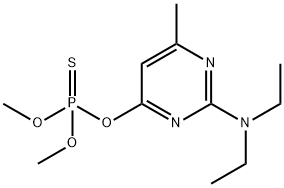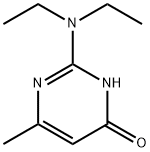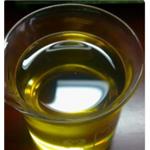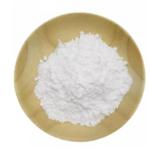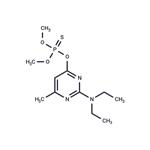Chemical Properties
Light yellow, straw colored, or amber oily liquid. Odorless when pure.
Uses
Pirimiphos-methyl is used to control a wide range of insect and
mite pests in stored products and a wide range of insects and mites on
agricultural crops, particularly sucking pests under glass.
Uses
Pirimiphos-methyl is a phosphorothioate used as an insecticide. Pirimiphos-methyl is commonly used for mosquito control as well as control of greenhouse crop pests and stored-product insects.
Definition
ChEBI: An organic thiophosphate that is O,O-dimethyl O-pyrimidin-4-yl phosphorothioate substituted by a methyl group at position 6 and a diethylamino group at position 2.
General Description
Yellow liquid. Corrosive to tin and mild steel. Used as an insecticide.
Air & Water Reactions
Hydrolyzed by strong acid or base.
Reactivity Profile
Organophosphates are susceptible to formation of highly toxic and flammable phosphine gas in the presence of strong reducing agents such as hydrides. Partial oxidation by oxidizing agents may result in the release of toxic phosphorus oxides.
Flammability and Explosibility
Not classified
Agricultural Uses
Insecticide, Acaricide: Pirimiphos-methyl is a post-harvest insecticide used to control a variety of insects in stored grain products and seed such as corn, rice, wheat and sorghum. It is also incorporated into cattle ear tags, and used for the fogging treatment of iris bulbs and pre-harvest clean up of fruits and vegetables.
Trade name
ACTELLIC®; ACTELLIFOG®; BLEX®; ENT 27699Gc®; DOMINATOR® EAR TAG; DOUBLE BARREL® EAR TAG; PLANT PROTECTION PP511®; PP511®; SILOSAN®; SYBOL®; TOMAHAWK®[C]
Safety Profile
Moderately toxic by
ingestion. Mutation data reported. When
heated to decomposition it emits very toxic
fumes of NOx, POx, and SOx.
Potential Exposure
Pirimiphos-methyl is a post -harves organophosphate insecticide/acaricide used to control a variety of insects in stored grain products and seed such as corn, rice, wheat and sorghum. It is also incorporated into cattle ear tags, and used for the fogging treatment of iris bulbs and preharvest cleanup of fruits and vegetables.
Carcinogenicity
When rats were given diets with
0, 10, 50, or 300 ppm pirimiphos methyl (equivalent to 0, 0.4,
2.1, or 12.6 mg/kg/day) for 2 years, 4 of the 42 high-dose
male rats had pancreatic islet cell adenomas and 1 had a
carcinoma compared to none in control male rats .
In a carcinogenicity study, mice were given diets with 0,
50, 200, or 400/300 ppm pirimiphos methyl (equivalent to 0,
8.3, 33, or 52 mg/kg/day (males); 0, 9.7, 39, or 61 mg/kg/day (females)) for 78 weeks . The initial 400 ppm dose
resulted in excessive toxicity and moribundity and was
reduced to 300 ppm after 8 days. There was no evidence
of carcinogenicity. In another mouse carcinogenicity study,
pirimiphos methyl was administered in the diet at levels of 0,
5, 250, or 500 ppm (equivalent to 0, 0.5, 25.9, or 45.0 mg/kg/
day (males) and 0, 0.6, 27.6, or 50.6 mg/kg/day (females),
respectively) for 80 weeks. The test diet for the highest dose
groups initially contained 300 ppm of the test compound (the
duration of treatment was not specified). The dose was then
increased weekly by 50 ppm to 500 ppm. No evidence of
carcinogenicity was observed.
Metabolic pathway
The metabolism of pirimiphos-methyl is similar in soils, plants and animals
and can be represented by initial hydrolysis to yield 2-diethylamino-
6-methyl-p yrimidin-4-0l which may be either conjugated or successively
N-de-ethylated. In plants, pirimiphos-methyl itself is N-de-ethylated. It is
probable that the oxon form of the compound is formed in many systems
but it is more labile than the parent compound and is often not detected.
0-Dealkylation, as with most organophosphates, is most probably a
major detoxification route in mammals but the evidence for it in the
case of pirimiphos-methyl is poor.
Shipping
UN2783 Organophosphorus pesticides, solid, toxic, Hazard Class: 6.1; Labels: 6.1-Poisonous materials. UN3018 Organophosphorus pesticides, liquid, toxic, Hazard Class: 6.1; Labels: 6.1-Poisonous materials.
Degradation
Pirimiphos-methyl is hydrolysed under both acidic and basic conditions
and is most stable at pH 7 (PM). The main product of hydrolysis was the
pyrimidinol (2). There is no information, however, on the degradation
products formed under either acidic or basic conditions. The DT
50 of
degradation was in the range of 3-4 days in sterile deionised water in the
dark. Photolysis was rapid but the products of photolytic breakdown
were not described (PSD, 1997).
Incompatibilities
May react violently with antimony(V) pentafluoride. Incompatible with strong acids and alkalies, lead diacetate, magnesium, silver nitrate. In the presence of strong reducing agents such as hydrides, organophosphates form highly toxic and flammable phosphine gas. Contact with oxidizers can cause the release of toxic oxides of phosphorus.
Waste Disposal
Destruction by alkali hydrolysis or incineration. Containers must be disposed of properly by following package label directions or by contacting your local or federal environmental control agency, or by contacting your regional EPA office.
